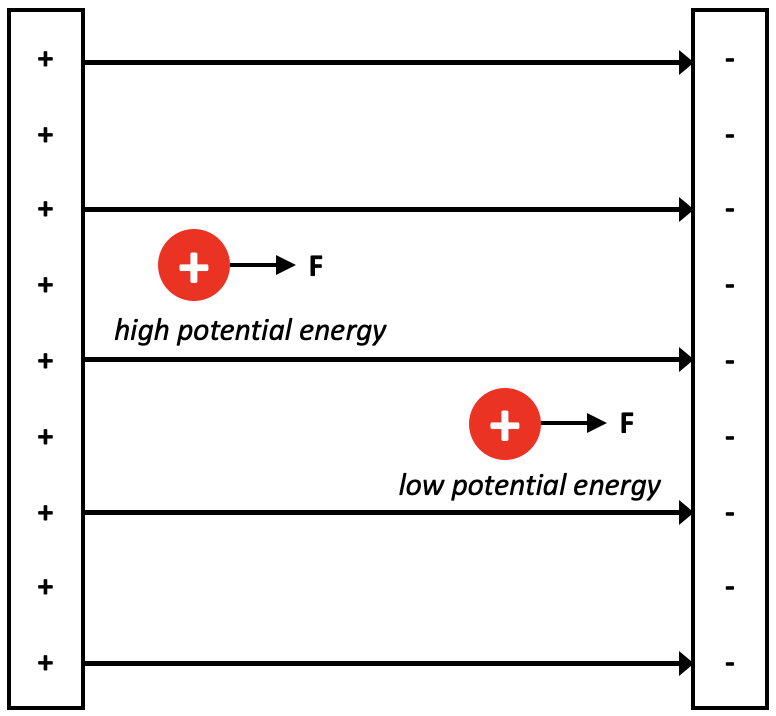Potential Energy and Voltage
12PHYS - Electricity
Finn Le Sueur
2024
Mahi Tuatahi
An object with charge \(25 \times 10^{-6}C\) is placed in an electric field with strength \(3000NC^{-1}\).
- Define electric field
- Calculate the force experienced by the object inside the electric field, and indicate direction
- Draw a diagram illustrating the situation
- Worksheet 1: Q6a, 6bb, Q11a, 11b, 11d
- Textbook: Electric Fields Q7-8 pg. 192
Whakatika
- An area of influence in where a charged object will feel a force
\[ \begin{aligned} E &= \frac{F}{q} \newline 3000 &= \frac{F}{25 \times 10^{-6}} \newline F &= 3000 \times 25 \times 10^{-6} \newline F &= 0.075N \end{aligned} \]
Ngā Whāinga Ako
- Be able to relate electric potential energy and voltage
- Use work in an electric field context
Write the date and ngā whāinga ako in your book
Electric Potential Energy
Electric potential energy is similar to gravitational potential energy. Moving a charged particle against the direction of the field is similar to lifting an object up in a gravitational potential field.
Therefore, different points in an electric field will have different potential energies

Gravity Field:
\[ \begin{aligned} & W = F \times d \newline & W = mg \times h \newline & W = mgh = E_{p-grav} \end{aligned} \]
Electric Field:
\[ \begin{aligned} & W = F \times d \newline & W = Eq \times d \newline & W = Eqd = E_{p-elec} \end{aligned} \]
Voltage
The difference in electric potential energy between two points
\[ \begin{aligned} V &= \frac{E_{p}}{q} \newline \text{Field Voltage} &= \frac{\text{Potential Energy}}{\text{Charge}} \end{aligned} \]
Mahi Tuatahi Continued
An object with charge \(25 \times 10^{-6}C\) is placed in an electric field with strength \(3000NC^{-1}\).
- In the object moves against the field by \(2m\), does it gain or lose electric potential energy? And how much?
Whakatika
Because it moves against the field, it gains electric potential energy.
\[ \begin{aligned} & E_{p} = Eqd \newline & E_{p} = 3000 \times 25 \times 10^{-6} \times 2 \newline & E_{p} = 0.15J \end{aligned} \]
Pātai
Homework booklet Electric Fields Question 4
Whakatika
Hamish connects a circuit comprised of a 6.0 V battery, 1.0 m of Nichrome resistance wire and two connecting wires. The battery produces a uniform electric field in the Nichrome resistance wire. Assume that the connecting wires have no resistance.
(a) Calculate the strength of the electric field in the Nichrome resistance wire. (A)
\[ \begin{aligned} & V=6V, d=1m && \text{(K)} \newline & E=? && \text{(U)} \newline & E = \frac{V}{d} && \text{(F)} \newline & E = \frac{6}{1} = 6Vm^{-1} && \text{(S+S)} \end{aligned} \]
(b) Explain what happens to the size of the electric force on an electron as it travels through the Nichrome resistance wire. (M)
Throughout the wire the field strength is constant, and the charge on the electron is also constant. Therefore using \(F=Eq\) we can see that the force is also constant.
(c) Calculate the distance moved by an electron as it loses 9.6 × 10-20 J of electrical potential energy. (M)
\[ \begin{aligned} & W = 9.6\times10^{-20}J, E = 6Vm^{-1}, q=-1.6\times10^{-19}&& \text{(K)} \newline & d = ? && \text{(U)} \newline & W = Fd = Eqd && \text{(F)} \newline & 9.6\times10^{-20} = 6 \times (-1.6\times10^{-19}) \times d && \text{(S+S)} \newline & d = \frac{9.6\times10^{-20}}{6 \times (-1.6\times10^{-19})} = 0.1m \end{aligned} \]
(d) Hamish then adds another 6.0 V battery in series AND shortens the wire to 0.50 m. Write a comprehensive explanation on what will happen to the size of the force on the electron. (E) Calculations are not needed.
- Adding another \(6V\) battery will double the electric field strength according to \(E = {V}{d}\).
- Shortening the wire from \(1m\) to \(0.5m\) will also double the field strength according to \(E = {V}{d}\).
- Both of these factors will result in a 4x stronger electric field.
- Assuming the charge of the electron stays constant, according to \(F=Eq\), the force experienced will also be 4x stronger.